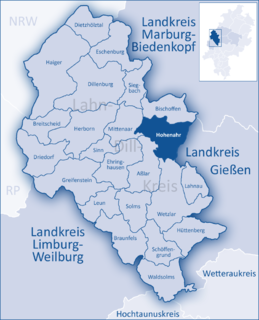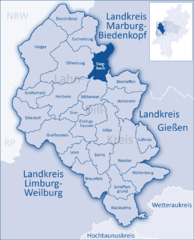
Herborn is a historic town on the Dill in the Lahn-Dill district of Hesse in Germany. Before World War I, it was granted its own title as Nassauisches Rothenburg. The symbol or mascot of this town is a bear. Scenic attractions include its half-timbered houses; Herborn is located on the German Timber-Frame Road. Herborn hosted the 26th Hessentag state festival in 1986, and the 56th Hessentag in 2016.
Lahn-Dill is a Kreis (district) in the west of Hesse, Germany. Neighboring districts are Siegen-Wittgenstein, Marburg-Biedenkopf, Gießen, Wetteraukreis, Hochtaunuskreis, Limburg-Weilburg, Westerwaldkreis.

Dillenburg, officially Oranienstadt Dillenburg, is a town in Hesse's Gießen region in Germany. The town was formerly the seat of the old Dillkreis district, which is now part of the Lahn-Dill-Kreis.

Eschenburg is a community in the Lahn-Dill-Kreis in Hesse, Germany. The community inherited its name from nearby Eschenburg mountain.

Angelburg is a community in western Marburg-Biedenkopf in northwest Middle Hesse in Germany.

Gladenbach [German pronunciation: [ˈɡlaːdn̩ˌbax](listen)] is a town in Hesse, Germany, in the west of Marburg-Biedenkopf district.

Bad Endbach is the westernmost municipality in Marburg-Biedenkopf district of the state of Hesse in Germany, and borders on the Lahn-Dill district.

Steffenberg is a municipality in Marburg-Biedenkopf district in Hesse, Germany.

Bischoffen is a municipality in the Lahn-Dill-Kreis in Hesse, Germany.

Breitscheid is a municipality in the Lahn-Dill-Kreis in Hesse, Germany.

Driedorf is a municipality in the Lahn-Dill-Kreis in Hesse, Germany.

Ehringshausen is a municipality in the Lahn-Dill-Kreis in Hesse, Germany.

Hohenahr is a municipality in the Lahn-Dill-Kreis in Hesse, Germany.

Mittenaar is a municipality in the Lahn-Dill-Kreis in Hesse, Germany.

Schöffengrund is a community in the Lahn-Dill-Kreis in Hesse, Germany.

Sinn is a community in Middle Hesse, Germany, in the Lahn-Dill-Kreis.

Waldsolms is a community located in the Lahn-Dill-Kreis in Hesse, Germany.

Mengerskirchen is a municipality in Limburg-Weilburg district in Hesse, Germany.
The Dernbach Feud was an over 100-year-long ongoing dispute in present-day Germany between the House of Nassau, several knightly families, and the Landgrave of Hesse. The conflict erupted mainly over property rights in Herborn and the surrounding area.





















